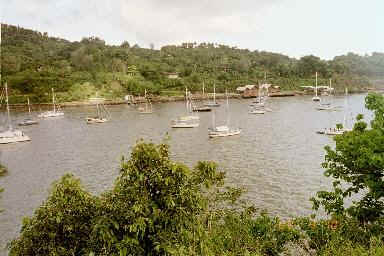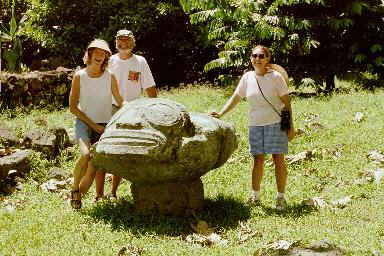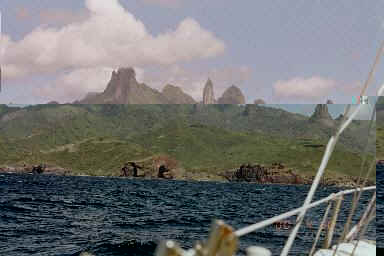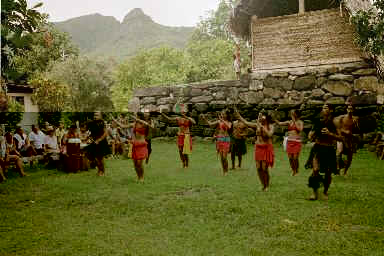Atuona harbour is fairly well protected by a
breakwater. It has several landing places for dinghies, taps where you can get fresh water
and a place to do laundry or take a shower. It is about two kilometers from the harbour to
the village of Atuona but you can take the school bus into town any weekday at 0730 free
of charge. Otherwise it's not a bad walk (especially after four weeks at sea) and we
rarely managed to walk the whole distance - we were almost always offered a ride by a
friendly Hiva Oan.
We cleared into French Polynesia at the Gendarmerie, paid our various entry fees
and bond and started sightseeing. Atuona is the second largest village in the Marquesas
and has a small museum, four grocery stores, two hardware stores, a couple of restaurants,
two churches, a bank, post office, school, hospital, and a lady who comes into town to
sell veggies from the back of her truck.Paul Gauguin and Jacques Brel are buried here so
we visited the cemetery to see the graves. It doesn’t take long to see all the
sights. |
 |
|
 |
We shared an expensive taxi ride for
an entire day with Bob and Cyn of TUCUMCARI and visited several historic sites around the
island. Lunch was al fresco by the beach, preceded by body surfing in the incoming swell.
The restored marae with the largest tiki in French Polynesia was very interesting. While in Atuona, the harbour became extremely rolly due to surge as
waves were reflected off the cliffs at the harbour entrance. At least two boats lost stern
anchors and one almost broached when hit broadside. We left the harbour as soon as we
could for the bay Hana Moe Noe on Tahuata Island. |
| From Tahuata we went overnight to Ua Pou which is by far the most
spectacular of the islands because of the tall, needle like, peaks. These are the remnants
of volcanic cores or plugs. They are solid gray stone, usually hiding in a cloud layer. We
met a number of townspeople on Ua Pou including the President of the Cultural Society (who
explained the myth of the creation
of the Marquesan Islands), the President of the Tourist Board and a hereditary priest. We
spent Easter at Ua Pou and enjoyed a performance by a group of local dancers, followed by
a Polynesian feast. There were four different breadfruit dishes, octopus in coconut milk,
poisson cru, which is raw fish (several types of tuna) in coconut milk and not unlike
sushi or seviche, salted smoked tuna, and lots of fruit. Two locals brought ukuleles and
played folk tunes. Vlad joined in and tried his hand with the help of one of the men. |
 |
|
 |
The Ua Pouans are proud of their Marquesan heritage and are trying
to teach their youngsters of the rich culture. There is a certain amount of animosity
towards Tahiti whose culture and language are different even though still Polynesian.
Tahiti is the governmental center but some Marquesans would prefer to have autonomy with
only France as the governmental centre. |
|
| From Ua Pou it is only twenty four miles to
Taiohae Bay on Nuku Hiva, the most populous island and the most commercial. At Ua Pou we
were able to get lots of fruit at no cost, whereas on Nuku Hiva fruit was difficult to get
since it is not sold in stores and it's harder to connect with the locals. We were in Nuku
Hiva at the beginning of the rainy season and it certainly did rain a lot. It was also
very hot in all the Marquesan islands - at only 9 deg S you are very close to the equator.
We were quite glad to leave and head for the drier, sunnier and slightly cooler Tuamotus. |
|



